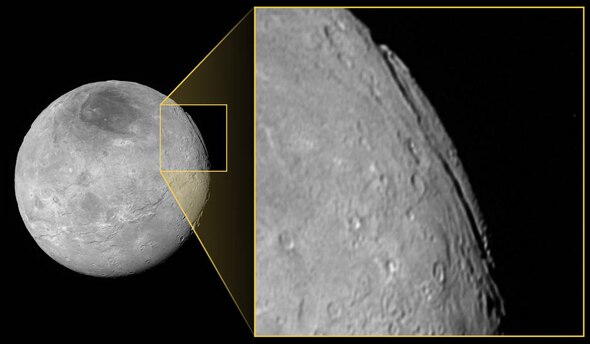Create a free profile to get unlimited access to exclusive videos, sweepstakes, and more!
The Cliffs of Charon

NASA released a photo of Pluto’s moon Charon the other day, and in the article about it they mentioned something I hadn’t thought of when I first saw the close-up photos of Charon last year. And I really should have!
First, as you can see in the above photo, Charon looks like nothing so much as Frankenstein’s moon: a satellite cobbled together from bits of others and slapped together rather haphazardly. The southern hemisphere is smooth, the northern rugged, the great blotch of Mordor staining the northern pole. What a mess!
In the upper right corner of the moon is what looks like a notch cut out of it, and it’s connected to a deep groove. The groove is a canyon named Argo Rupes,* and the scale of it is massive—if you can call a lack of something massive. It’s 700 kilometers long, and about 9 kilometers deep. That dwarfs the Grand Canyon, which is less than 2 kilometers in depth and 450 kilometers in length.
The high-res image of Charon from New Horizons came back the very day the spacecraft whizzed by Pluto and the moon, in July 2015, and even then the notch and canyon were obvious. But what hadn’t occurred to me at the time was to wonder how tall the sheer cliffs in that canyon might be. It’s hard to tell in the image because the resolution makes it difficult to know just how steep the walls are, and if there are ledges along the face.
But, if some of the walls are steep and sheer enough, they could qualify Charon for having the tallest cliffs in the solar system! That record right now is held by Miranda, a moon of Uranus. Verona Rupes on that icy worldlet has cliffs at least ten kilometers high (the NASA article about Charon says five, but many sources list it as 10 and even some as 20). So it’s hard to say whether Charon can edge out Miranda or not.
It may seem odd at first blush that both objects are small (Charon is 1,200 km wide, and Miranda just 470), yet they have cliffs so tall. But then that might be why: Under Earth’s gravity a cliff so tall would probably crumble under the weight of so much rock; the bottom would collapse.
It’s hard to look at those cliffs and not wonder how long it would take to fall from the top to the base. On Miranda it’s hard to say; it depends on the actual height, but due to the moon’s weak gravity it would take something like eight minutes or more! If the cliffs on Charon are 9 km high, it would take a little more than four minutes. Charon has much stronger gravity than Miranda, so it accelerates a falling body more rapidly, and the time to fall is less.
What would that look like, though? Well, given the chance I can’t pass up the opportunity to repost this phenomenal and inspiring video by Erik Wernquist called “Wanderers.” The Miranda moment is at 2:41, but trust me, you want to watch the whole thing.
What a thing, to dive the cliffs of the icy words of the outer solar system. Perhaps, one day, our descendants will be able to do just that.
*Features on Charon are informally named after fictional adventurers, their destinations, or the vessels that took them there. Argo was the ship of Jason, rightful king of Iolcus, who sought the Golden Fleece.


























